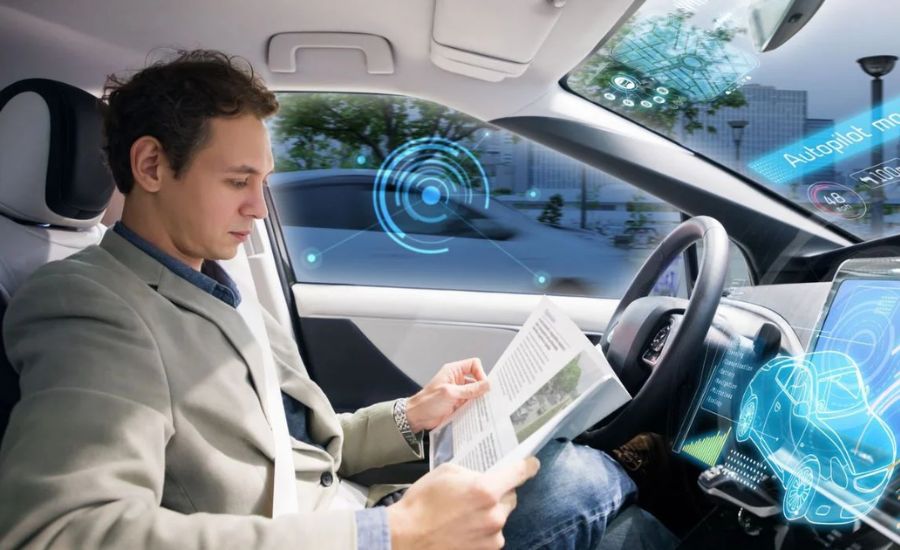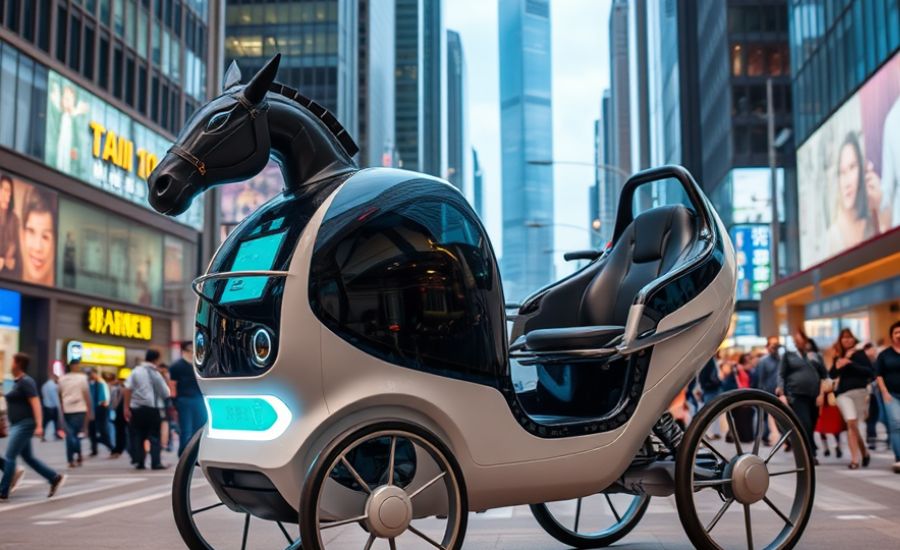Daytimestar.com: taipei self-driving gharry Introduction, What is, How Does & More
Introduction
Taiwan’s dynamic capital, Taipei, has long been praised for its harmonious blend of modernism and heritage. With self-driving gharries, a futuristic, environmentally friendly take on the traditional horse-drawn carriage, the city is now embracing transportation innovation.
These driverless cars provide a distinctive way to see Taipei, letting visitors take in the city’s fascinating past while savoring state-of-the-art amenities.
We will look more closely at Taipei’s self-driving gharries in this blog, including their operation and how they are changing how locals and visitors alike get around the center of Taiwan.
What is the daytimestar.com: taipei self-driving gharry?

In colonial India, the word “gharry” was first used to describe a horse-drawn carriage that was utilized for urban transit in places like Delhi, Mumbai, and Kolkata. This age-old type of transportation has changed over time to stay up with contemporary developments.
The self-driving gharry is a ground-breaking interpretation of an ancient idea in Taipei. In contrast to its predecessor, this car runs on its own, using sophisticated sensor technology, machine learning, and artificial intelligence (AI) to traverse the city without a human driver.
The firm that created this innovation, DaytimeStar.com, has reimagined the gharry for the current era by skillfully fusing nostalgia with cutting-edge technology. Taipei’s self-driving gharry offers a safe, effective, and environmentally responsible method to get around the city by incorporating autonomous technology into a historically significant vehicle. In addition to improving urban mobility, this cutting-edge transit system is essential to Taiwan’s public transportation infrastructure modernization.
How Does the daytimestar.com: taipei self-driving gharry Work?
Modern technology is integrated into the self-driving gharry to provide a smooth and completely autonomous travel experience. The car functions without requiring human interaction thanks to a combination of artificial intelligence, sophisticated sensors, GPS, and clever algorithms.
Machine learning and artificial intelligence (AI)
A sophisticated AI system that analyzes data from several sensors and cameras is at the core of the self-driving gharry. The car can maneuver through congested streets, avoid obstructions, and maximize movement thanks to this AI. The system continuously learns from and adjusts to its environment over time, increasing its effectiveness and capacity for making decisions.
Cutting-edge cameras and sensors
With its cutting-edge technology, the self-driving gharry makes use of:
Light Detection and Ranging, or LiDAR, is used to produce a three-dimensional map of its surroundings.
ultrasonic sensors to identify objects in the vicinity and avoid collisions.
cameras with high resolution to detect traffic signals, cars, and pedestrians.
Together, these elements offer a 360-degree perspective, guaranteeing accurate and safe navigation.
Real-time mapping and GPS
The car uses dynamic mapping software and GPS to figure out the best path across Taipei’s streets. The gharry can adjust to current road conditions, pedestrian activity, and traffic patterns thanks to its technology. Traveling is made convenient and predictable by the ability for passengers to track their ride through a mobile app.
Algorithms for Autonomous Driving
Intelligent driving algorithms power the self-driving gharry, regulating its direction, speed, and braking systems. The car can do the following thanks to these algorithms:
Navigate through intricate urban settings.
React quickly to unforeseen challenges.
Make sure the passengers have a safe and easy trip.
By combining these
With its cutting-edge features, Taipei’s self-driving gharry is a safe, effective, and environmentally responsible substitute for conventional modes of urban transit.
The Benefits of Self-Driving Gharrys in Taipei

With its many benefits, Taipei’s introduction of self-driving gharrys is redefining urban transit in terms of accessibility, efficiency, and sustainability.
1. Eco-friendliness and sustainability
By running on electricity, Taipei’s self-driving gharrys help cities throughout the world cut their carbon footprints. These cars are an eco-friendly substitute for conventional fuel-powered transportation because they emit no pollutants. Taipei is making great strides in lowering pollution and increasing air quality by incorporating sustainable energy solutions, which will increase urban sustainability overall.
2. Less Traffic Jams
Traffic congestion is a frequent problem in Taipei because of its crowded streets and dense population. By reducing the number of personal vehicles on the road, choosing effective routes to cut down on travel time, and using clever navigation systems to avoid bottlenecks, self-driving cars assist optimize traffic flow.
These driverless cars help create a more efficient, quicker, and well-organized transportation system by encouraging better traffic management.
3. Enhanced Convenience and Accessibility
Transportation for the elderly and others with mobility issues is made easier by self-driving gharrys, which offer a smooth and hassle-free travel experience.
People who live in places where public transportation is scarce.
✔️ Visitors can explore the city without having to deal with intricate transit networks.
Passengers can go directly and stress-free to their destinations without the need for human drivers.
4. Economical Transportation
Even if self-driving car technology demands a large upfront investment, the long-term advantages exceed the costs:
🔹 Lower operating costs because there are no human drivers.
Reduced dependence on private automobiles, which saves inhabitants money on fuel and upkeep.
Therefore, self-driving gharrys offer a cost-effective mode of transportation, increasing the accessibility and affordability of urban transit for both Taipei locals and tourists.
Taipei’s self-driving gharry system is set to revolutionize urban mobility while improving the city’s efficiency, accessibility, and environmental responsibility by fusing sustainable technology, intelligent navigation, and affordability.
Key Advantages That Will Impress You
By merging technical advancement with Taipei’s rich cultural legacy, the contemporary self-driving gharry is revolutionizing urban mobility in the city. These fully autonomous cars provide a number of important advantages, including safer, more effective, and more tourist-friendly transportation.
1. Environmentally friendly
The environmental sustainability of self-driving cars is one of their biggest benefits. Since they emit no pollutants, these electric vehicles (EVs) provide a greener option to conventional fuel-powered transportation. These cars help make Taipei cleaner and greener by lowering carbon emissions and air pollution.
2. Optimization of Traffic
The purpose of self-driving gharrys is to enhance traffic flow and lessen congestion. Their small size enables them to move quickly through congested areas, and their sophisticated routing systems dynamically modify routes to prevent traffic jams by evaluating road conditions in real time. As a result, Taipei’s streets remain more orderly and less crowded.
3. An Experience That is Friendly to Tourists
Self-driving gharrys do not have set timetables like regular public transportation, so visitors can take their time seeing Taipei. Without being constrained by strict bus or rail schedules, travelers may take advantage of a customized travel experience whether they are visiting historical sites or contemporary attractions.
4. Convenient and hassle-free
Without having to worry about driving, passengers can unwind and enjoy their trip thanks to fully autonomous operation. Travelers may just relax, enjoy the views, and explore Taipei without any interruptions—no need to worry about traffic, navigation, or route planning.
Taipei’s self-driving gharry is revolutionizing urban travel by fusing innovation, sustainability, and convenience, making transit safer, greener, and more accessible for both locals and visitors.
Benefits of Using Taipei’s Self-Driving Gharry
In Taipei, self-driving gharries are transforming urban mobility by providing a cutting-edge, environmentally friendly, and effective substitute for conventional modes of transportation. Here are some reasons why locals and tourists alike are choosing them:
Convenience
Self-driving gharries offer a smooth and hassle-free travel experience and are easily booked through smartphone apps. With just a few touches, passengers can order a transport, doing away with the need for lengthy wait times or intricate route planning.
Sustainable
These electric-powered vehicles support Taipei’s sustainability initiatives and lower carbon emissions. Self-driving gharries are essential to advancing clean and energy-efficient transportation as the city strives for greener options.
Enhanced Safety
These autonomous cars are much safer than traditional taxis since they are outfitted with AI-driven monitoring systems that include collision detection, real-time traffic analysis, and emergency response mechanisms.
Economical
Urban travel is becoming more economical because to self-driving gharries, which have lower operating expenses than traditional taxis or ride-hailing services.
Friendly to Visitors
By removing language barriers and guaranteeing a seamless, educational, and pleasurable travel experience, multilingual AI-powered assistants assist visitors in navigating Taipei.
In Taipei, self-driving gharries are revolutionizing transportation with their state-of-the-art technology, eco-friendly features, and intuitive design.
Facts :
- Origin of the Term “Gharry”
- Originally used in colonial India to describe horse-drawn carriages used for urban transport.
- Taipei’s self-driving gharry modernizes this concept with autonomous technology.
- Technology Behind Self-Driving Gharries
- AI and Machine Learning: Analyzes traffic patterns, avoids obstacles, and improves navigation over time.
- LiDAR and Sensors: Uses 360-degree monitoring to detect pedestrians, vehicles, and road conditions.
- GPS and Real-Time Mapping: Adjusts routes dynamically based on traffic and road conditions.
- Autonomous Driving Algorithms: Ensures safe speed regulation, decision-making, and emergency responses.
- Environmental Benefits
- Operates on electric power, emitting zero harmful emissions.
- Supports Taipei’s sustainability goals and helps reduce urban pollution.
- Advantages Over Traditional Transport
- Reduces traffic congestion by optimizing routes.
- Cost-effective as there is no need for human drivers.
- Enhances accessibility for tourists and individuals with mobility challenges.
- Multilingual AI assistants help tourists navigate the city without language barriers.
Summary :
Taipei’s self-driving gharry is a groundbreaking innovation that blends modern technology with historical transportation concepts. Inspired by traditional horse-drawn carriages, these fully autonomous vehicles provide a safe, efficient, and eco-friendly way to navigate the city.
Powered by AI, machine learning, and advanced sensors, these vehicles operate without human drivers, ensuring smooth, real-time navigation. Their introduction aims to reduce carbon emissions, improve traffic flow, and enhance accessibility for residents and tourists.
By integrating sustainability, smart routing, and user convenience, Taipei’s self-driving gharry system is redefining urban mobility and setting a precedent for future autonomous transport solutions.
FAQs :
1. What is a self-driving gharry?
A self-driving gharry is an autonomous electric vehicle that operates without a human driver, using AI, GPS, sensors, and machine learning to navigate Taipei’s streets safely.
2. How does the self-driving gharry work?
The vehicle uses a combination of LiDAR, ultrasonic sensors, and high-resolution cameras to detect surroundings. AI-powered systems analyze traffic data, predict road conditions, and adjust routes dynamically.
3. Are self-driving gharries safe?
Yes, they are equipped with collision detection, emergency braking, and real-time traffic monitoring to ensure passenger and pedestrian safety.
4. How can I book a self-driving gharry in Taipei?
Passengers can book a ride through mobile apps, similar to ride-hailing services like Uber, allowing for easy and convenient transportation.
5. Are self-driving gharries environmentally friendly?
Yes, they run on electric power, producing zero emissions, making them a sustainable alternative to gas-powered taxis and buses.
6. Can tourists use self-driving gharries?
Absolutely! These vehicles feature multilingual AI assistants to help tourists navigate the city and explore Taipei without language barriers.
7. How do self-driving gharries help with traffic congestion?
They use optimized routes and real-time traffic analysis to avoid bottlenecks, reducing overall congestion in Taipei’s busy streets.
8. Are self-driving gharries expensive to use?
No, they are cost-effective due to lower operational costs (no human drivers), making them an affordable option compared to traditional taxis.
9. How do self-driving gharries compare to buses and trains?
Unlike buses and trains, self-driving gharries do not follow fixed schedules and offer on-demand rides, making them more flexible and convenient for passengers.
10. What is the future of self-driving gharries in Taipei?
With advancements in AI and autonomous technology, Taipei aims to expand the fleet, enhance safety features, and integrate these vehicles more deeply into its public transportation system.
Read More information About Blog At royalbucks.net






